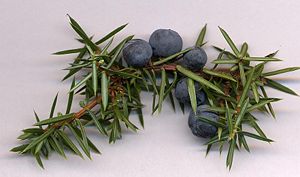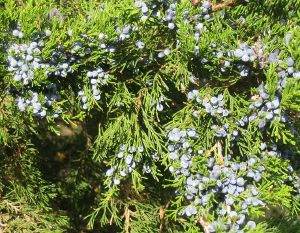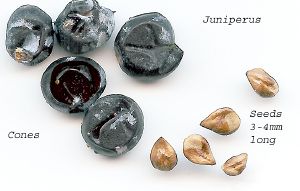Juniper
Template:Alternateuses
| Juniperus | ||||||||||||
|---|---|---|---|---|---|---|---|---|---|---|---|---|
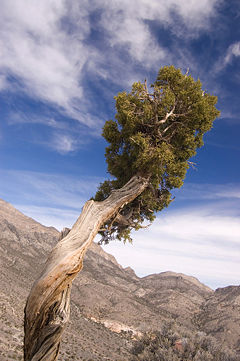 Juniperus osteosperma in Nevada
| ||||||||||||
| Scientific classification | ||||||||||||
| ||||||||||||
|
See text |
Junipers are coniferous plants in the genus Juniperus of the cypress family Cupressaceae. Depending on taxonomic viewpoint, there are between 50-67 species of juniper, widely distributed throughout the northern hemisphere, from the Arctic, south to tropical Africa in the Old World, and to the mountains of Central America.
Description
Junipers vary in size and shape from tall trees, 20-40 m tall, to columnar or low spreading shrubs with long trailing branches. They are evergreen with needle-like and/or scale-like leaves. They can be either monoecious or dioecious. The female seed cones are very distinctive, with fleshy, fruit-like coalescing scales which fuse together to form a "berry"-like structure, 4-27 mm long, with 1-12 unwinged, hard-shelled seeds. In some species these "berries" are red-brown or orange but in most they are blue; they are often aromatic (for their use as a spice, see juniper berry). The seed maturation time varies between species from 6-18 months after pollination. The male cones are similar to those of other Cupressaceae, with 6-20 scales; most shed their pollen in early spring, but some species pollinate in the autumn.
Many junipers (e.g. J. chinensis, J. virginiana) have two types of leaves: seedlings and some twigs of older trees have needle-like leaves 5-25 mm long; and the leaves on mature plants are (mostly) tiny (2-4 mm long), overlapping and scale-like. When juvenile foliage occurs on mature plants, it is most often found on shaded shoots, with adult foliage in full sunlight. Leaves on fast-growing 'whip' shoots are often intermediate between juvenile and adult.
In some species (e.g. J. communis, J. squamata), all the foliage is of the juvenile needle-like type, with no scale leaves. In some of these (e.g. J. communis), the needles are jointed at the base, in others (e.g. J. squamata), the needles merge smoothly with the stem, not jointed.
The needle-leaves of junipers are hard and sharp, making the juvenile foliage very prickly to handle. This can be a valuable identification feature in seedlings, as the otherwise very similar juvenile foliage of cypresses (Cupressus, Chamaecyparis) and other related genera is soft and not prickly.
Juniper is the exclusive food plant of the larvae of some Lepidoptera species including Bucculatrix inusitata and Juniper Carpet and is also eaten by the larvae of other Lepidoptera species such as Chionodes electella, Chionodes viduella, Juniper Pug and Pine Beauty.
Cultivation and uses
Juniper berries are a spice used in a wide variety of culinary dishes and best known for the primary flavoring in gin (and responsible for gin's name, which is a shortening of the Dutch word for Juniper: genever). Juniper berries are also used as the primary flavor in the liquor Jenever and sahti-style of beers. Juniper berry sauce is often a popular flavoring choice for quail, pheasant, veal, rabbit, venison and other meat dishes.
Many of the earliest prehistoric people lived in or near juniper forests which furnished them food, fuel, and wood for shelter or utensils. Many species, such as J. chinensis (Chinese Juniper) from eastern Asia, are extensively used in landscaping and horticulture, and as one of the most popular species for use in bonsai. It is also a symbol of longevity, strength, athleticism, and fertility.
Some junipers are susceptible to Gymnosporangium rust disease, and can be a serious problem for those people growing apple trees, the alternate host of the disease.
Some juniper trees are misleadingly given the common name "cedar"— including the "red cedar" that is used widely in cedar drawers. True cedars are those tree species in the genus Cedrus, family Pinaceae.
Juniper berries have long been used as medicine by many cultures. Juniper berries act as a strong urinary tract disinfectant if consumed and were used by American Indians as a herbal remedy for urinary tract infections. Western tribes combined the berries of juniperus communis with Berberis root bark in a herbal tea to treat diabetes. Clinical studies have verified the effectiveness of this treatment in insulin-dependent diabetes. Compounds in these plants when combined and ingested have been shown to trigger insulin production in the body's fat cells, as well as stabilize blood sugar levels. Native Americans also used juniper berries as a female contraceptive. [1] The 17th Century herbalist physician Nicholas Culpeper recommended the ripened berries for conditions such as asthma and sciatica, as well as to speed childbirth. [2]
Classification
The number of juniper species is in dispute, with two recent studies giving very different totals, Farjon (2001) accepting 52 species, and Adams (2004) accepting 67 species. The junipers are divided into several sections, though (particularly among the scale-leaved species) which species belong to which sections is still far from clear, with research still on-going. The section Juniperus is an obvious monophyletic group though.
- Juniperus sect. Juniperus: Needle-leaf junipers. The adult leaves are needle-like, in whorls of three, and jointed at the base (see below right).
- Juniperus sect. Juniperus subsect. Juniperus: Cones with 3 separate seeds; needles with one stomatal band.
- Juniperus communis - Common Juniper
- Juniperus communis subsp. alpina - Alpine Juniper
- Juniperus conferta - Shore Juniper (syn. J. rigida var. conferta)
- Juniperus rigida - Temple Juniper or Needle Juniper
- Juniperus communis - Common Juniper
- Juniperus sect. Juniperus subsect. Oxycedrus: Cones with 3 separate seeds; needles with two stomatal bands.
- Juniperus brevifolia - Azores Juniper
- Juniperus cedrus - Canary Islands Juniper
- Juniperus deltoides - Eastern Prickly Juniper
- Juniperus formosana - Chinese Prickly Juniper
- Juniperus lutchuensis - Ryukyu Juniper
- Juniperus navicularis - Portuguese Prickly Juniper
- Juniperus oxycedrus - Western Prickly Juniper or Cade Juniper
- Juniperus macrocarpa (J. oxycedrus subsp. macrocarpa) - Large-berry Juniper
- Juniperus sect. Juniperus subsect. Caryocedrus: Cones with 3 seeds fused together; needles with two stomatal bands.
- Juniperus drupacea - Syrian Juniper
- Juniperus sect. Juniperus subsect. Juniperus: Cones with 3 separate seeds; needles with one stomatal band.
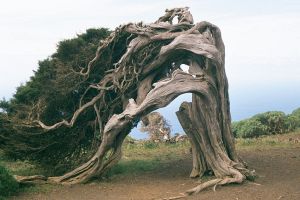
- Juniperus sect. Sabina: Scale-leaf junipers. The adult leaves are mostly scale-like, similar to those of Cupressus species, in opposite pairs or whorls of three, and the juvenile needle-like leaves are not jointed at the base (including in the few that have only needle-like leaves; see below right). Provisionally, all the other junipers are included here, though they form a paraphyletic group.
- Old World species
- Juniperus chinensis - Chinese Juniper
- Juniperus chinensis var. sargentii - Sargent's Juniper
- Juniperus convallium - Mekong Juniper
- Juniperus excelsa - Greek Juniper
- Juniperus polycarpos - Persian Juniper
- Juniperus foetidissima - Stinking Juniper
- Juniperus indica - Black Juniper
- Juniperus komarovii - Komarov's Juniper
- Juniperus phoenicea - Phoenicean Juniper
- Juniperus procera - East African Juniper
- Juniperus procumbens - Ibuki Juniper
- Juniperus pseudosabina - Xinjiang Juniper
- Juniperus recurva - Himalayan Juniper
- Juniperus recurva var. coxii - Cox's Juniper
- Juniperus sabina - Savin Juniper
- Juniperus sabina var. davurica - Daurian Juniper
- Juniperus saltuaria - Sichuan Juniper
- Juniperus semiglobosa - Russian Juniper
- Juniperus squamata - Flaky Juniper
- Juniperus thurifera - Spanish Juniper
- Juniperus tibetica - Tibetan Juniper
- Juniperus wallichiana - Himalayan Black Juniper
- Juniperus chinensis - Chinese Juniper
- New World species
- Juniperus angosturana - Mexican One-seed Juniper
- Juniperus ashei - Ashe Juniper
- Juniperus barbadensis - West Indies Juniper
- Juniperus bermudiana - Bermuda Juniper
- Juniperus blancoi - Blanco's Juniper
- Juniperus californica - California Juniper
- Juniperus coahuilensis - Coahuila Juniper
- Juniperus comitana - Comitán Juniper
- Juniperus deppeana - Alligator Juniper
- Juniperus durangensis - Durango Juniper
- Juniperus flaccida - Mexican Weeping Juniper
- Juniperus gamboana - Gamboa Juniper
- Juniperus horizontalis - Creeping Juniper
- Juniperus jaliscana - Jalisco Juniper
- Juniperus monosperma - One-seed Juniper
- Juniperus monticola - Mountain Juniper
- Juniperus occidentalis - Western Juniper
- Juniperus occidentalis subsp. australis - Sierra Juniper
- Juniperus osteosperma - Utah Juniper
- Juniperus pinchotii - Pinchot Juniper
- Juniperus saltillensis - Saltillo Juniper
- Juniperus scopulorum - Rocky Mountain Juniper
- Juniperus standleyi - Standley's Juniper
- Juniperus virginiana - Eastern Juniper (Eastern Redcedar)
- Juniperus virginiana subsp. silicicola - Southern Juniper
- Old World species
ReferencesISBN links support NWE through referral fees
- Adams, R. P. (2004). Junipers of the World: The genus Juniperus. Victoria: Trafford. ISBN 1-4120-4250-X
- Farjon, A. (2001). World Checklist and Bibliography of Conifers. Kew. ISBN 1-84246-025-0
- Farjon, A. (2005). Monograph of Cupressaceae and Sciadopitys. Royal Botanic Gardens, Kew. ISBN 1-84246-068-4
External links
- Junipers of the world
- Gymnosperm Database - Juniperus
- Arboretum de Villardebelle Photos of cones and foliage of selected species
Credits
New World Encyclopedia writers and editors rewrote and completed the Wikipedia article in accordance with New World Encyclopedia standards. This article abides by terms of the Creative Commons CC-by-sa 3.0 License (CC-by-sa), which may be used and disseminated with proper attribution. Credit is due under the terms of this license that can reference both the New World Encyclopedia contributors and the selfless volunteer contributors of the Wikimedia Foundation. To cite this article click here for a list of acceptable citing formats.The history of earlier contributions by wikipedians is accessible to researchers here:
The history of this article since it was imported to New World Encyclopedia:
Note: Some restrictions may apply to use of individual images which are separately licensed.
- ↑ Edible and Medicinal Plants of the West, Gregory L. Tilford, ISBN 0-87842-359-1
- ↑ Culpeper's Complete Herbal, Nicholas Culpeper, ISBN 1-85007-026-1
